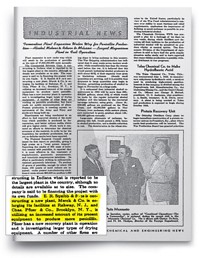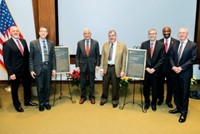Advertisement
Grab your lab coat. Let's get started
Welcome!
Welcome!
Create an account below to get 6 C&EN articles per month, receive newsletters and more - all free.
It seems this is your first time logging in online. Please enter the following information to continue.
As an ACS member you automatically get access to this site. All we need is few more details to create your reading experience.
Not you? Sign in with a different account.
Not you? Sign in with a different account.
ERROR 1
ERROR 1
ERROR 2
ERROR 2
ERROR 2
ERROR 2
ERROR 2
Password and Confirm password must match.
If you have an ACS member number, please enter it here so we can link this account to your membership. (optional)
ERROR 2
ACS values your privacy. By submitting your information, you are gaining access to C&EN and subscribing to our weekly newsletter. We use the information you provide to make your reading experience better, and we will never sell your data to third party members.
ACS News
ACS honors insulin development
Advances that enabled commercialization earn Historic Chemical Landmark designation
by Sophie Rovner, ACS staff
May 7, 2023
| A version of this story appeared in
Volume 101, Issue 15

Diabetes used to be a death sentence, killing people by disrupting sugar metabolism. But in 1922, University of Toronto researchers and physicians successfully treated a boy with diabetes by injecting him with insulin extracted from animal pancreases. Physicians clamored for the new drug, so the university began collaborating with Eli Lilly and Company to satisfy the demand. The company refined and scaled up production techniques and delivered the world’s first commercial doses in 1923. The American Chemical Society honored Lilly’s role in these achievements with a National Historic Chemical Landmark designation ceremony in Indianapolis on March 27.
Speakers at the event included ACS president-elect Mary Carroll and Leonard Glass, senior vice president of Lilly diabetes global medical affairs. “The global pandemic has demonstrated unambiguously that science matters,” Carroll said. “It has shown the critical importance of performing and publishing rigorous scientific work, educating students, and communicating science to elected officials and other members of the general public.”
The recorded history of diabetes stretches back 3,500 years, when symptoms were mentioned on an Egyptian papyrus. For millennia, little could be done to help people with the condition. But just over a century ago, everything changed.
In December 1921, 14-year-old Leonard Thompson was near death from diabetes. After a month in Toronto General Hospital, he wasn’t improving, so his physicians turned to an experimental treatment being developed by researchers at the University of Toronto. In January 1922, the doctors cautiously injected Thompson with pancreatic fluid extracted from cows.
The team hoped to confirm what it had already seen in animals: insulin in the extract could regulate blood sugar. As it turned out, the injection saved Thompson’s life.
Physicians who heard about the new wonder drug were desperate to obtain it to save their own dying patients, but the university was unable to produce significant quantities. In May 1922, Lilly began collaborating with the university to scale up and commercialize insulin production from animal extracts. The effort was led by chemist George Walden.
By July, the firm had shipped its first batches of insulin for clinical testing. Lilly then devised a new method to purify the animal extract. In 1923, the company began full-scale animal insulin production using this separation technique. This approach revolutionized the purity and stability of the final product, paving the way for mass production.
Collaboration and licensing agreements allowed the supply of insulin from additional companies, including the nonprofit Nordisk Insulin Laboratory (which later became Novo Nordisk) and Hoechst (a predecessor of Sanofi). Innovations followed, such as increasing purity to improve tolerance, using microbes for production, and creating beneficial analogs.
Because of these advances, millions of people have been treated with insulin since the 1920s. For those with access to treatment, a once-fatal illness has turned into a manageable chronic disease.
ACS established the National Historic Chemical Landmarks program in 1992 to recognize critical events in the history of chemistry and to increase public awareness of chemistry’s contributions to society. Find more information at www.acs.org/landmarks.





Join the conversation
Contact the reporter
Submit a Letter to the Editor for publication
Engage with us on Twitter